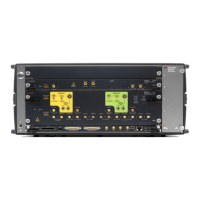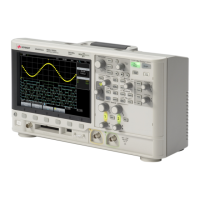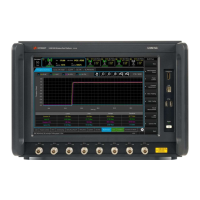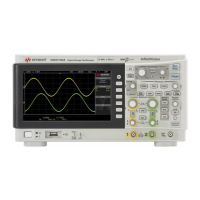516 Keysight M8000 Series of BER Test Solutions User Guide
8 Working with Measurements
Up Log + Linear The Up Log + Linear search algorithm performs the same
algorithm as Up Logarithmic, but in addition, it returns to the last
passing amplitude and steps linearly up until it reaches a fail
point. The algorithm continues to increase the SJ amplitude until
failure, even if it surpassed the original failed point.
Adaptive Binary The adaptive binary algorithm is a combination of an up
logarithmic search and a binary search. The initial search at the
start frequency uses the logarithmic step size for the upwards
search and switches to a binary search when the first failed
measurement point is found.
The binary search is reducing the step size until it becomes
smaller as the defined binary step size. For all following jitter
frequencies, the search starts at the last known pass amplitude.
This algorithm is most efficient when the search is configured to
start with the high jitter frequency, and therefore usually less
points to measure until it finds the first fail.
The advantage over the binary algorithm is, that it avoids
measuring unnecessary pass points at low jitter amplitude, as well
as avoiding the maximum jitter amplitude. Avoiding the excessive
jitter condition helps saving measurement time because the
number of times the device under test needs to recover will be
less than with a simple binary search.
Custom Custom algorithms can be implemented using the DUT Control
Interface. This allows to implement search algorithms that select
the jitter amplitude in a way that it optimizes measurement time,
or excessive jitter conditions in a way that is not covered by the
standard search algorithms.
The search algorithm is defined by the implementation of three
dedicated DUT Control Interface hooks.
• JTOL_CustomAlgorithm_InitializeFrequency
• JTOL_CustomAlgorithm_GetNextAmplitude
• JTOL_CustomAlgorithm_IsLastPointAtCurrentFrequency
A tutorial script 'JTOL-Custom-Algorithm-with-Virtual-DUT.py' is
part of the M8070A installation and is demonstrates how to
implement the algorithm correctly.
This algorithm requires the DUT Control Interface license
(M8070A-1TP, M8070A-1NP or M8070A-1TT) .
Name Description

